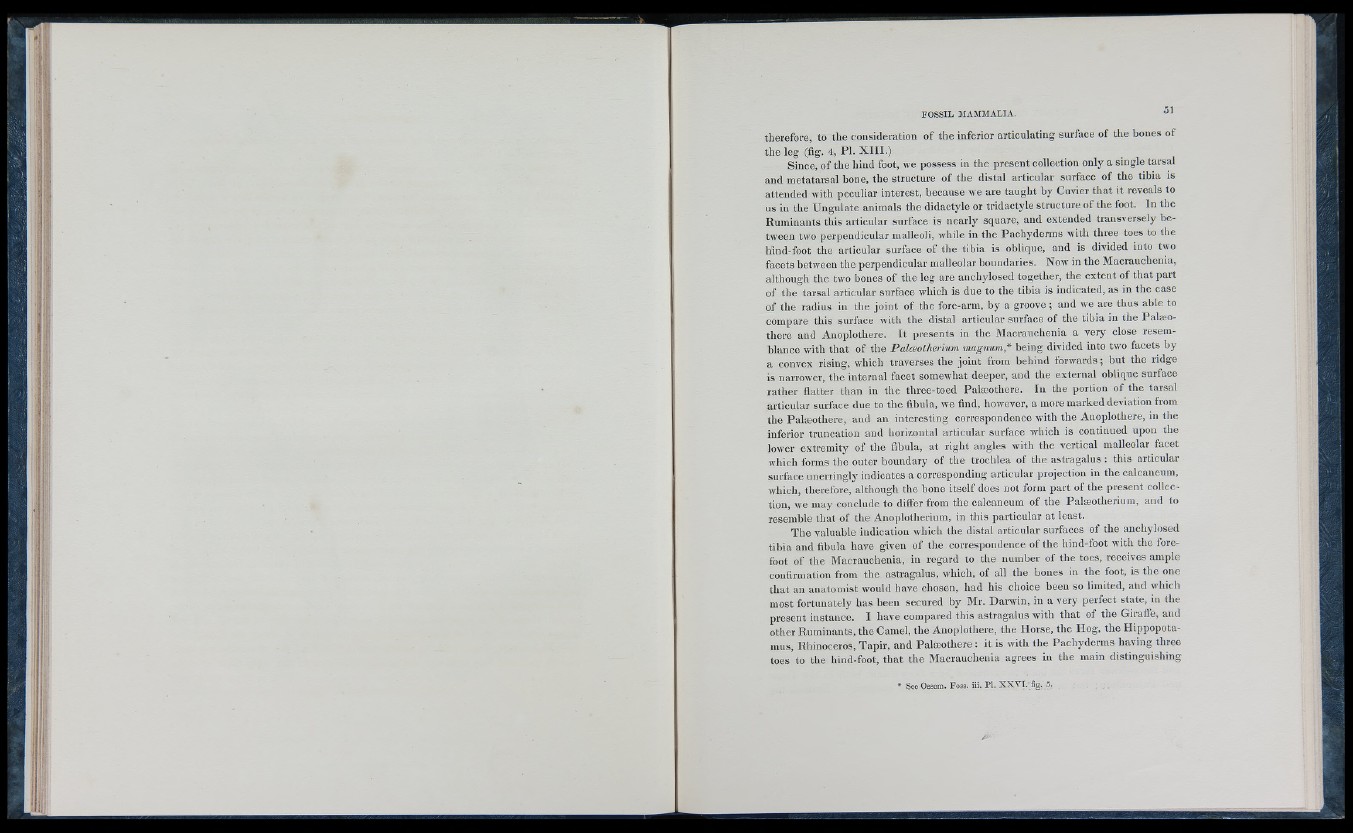
therefore, to the consideration o f the inferior articulating surface o f the bones of
the leg (fig. 4, PI. X I I I .)
Since, o f the hind foot, we possess in the present collection only a single tarsal
and metatarsal bone, the structure o f the distal articular surface o f the tibia is
attended with peculiar interest, because we are taught by Cuvier that it reveals to
us in the Ungulate animals the didactyle or tridactyle structure o f the foot. In the
Ruminants this articular surface is nearly square, and extended transversely b e tween
two perpendicular malleoli, while in the Pachyderms with three toes to the
hind-foot the articular surface o f the tibia is oblique, and is divided into two
facets between the perpendicular malleolar boundaries. Now in the Macrauchenia,
although the two bones o f the leg are ancliylosed together, the ex tent o f that part
o f the tarsal articular surface which is due to the tibia is indicated, as in the case
o f the radius in tlie joint o f the fore-arm, by a groove ; and we are thus able to
compare this surface with the distal articular surface o f the tibia in the Pa læo there
and Anoplothere. It presents in the Macranclienia a very close resemblance
with that o f the Palæothermm magnum,* being divided into two facets by
a convex rising, which traverses the joint from behind forwards ; but the ridge
is narrower, tlie internal facet somewhat deeper, and the external oblique surface
rather flatter than in the three-toed Palæothere. lu the portion o f the tarsal
articular surface due to the fibula, we find, however, a more marked deviation from
the Palæothere, and an interesting correspondence with the Anoplothere, in the
inferior truncation and horizontal articular surface which is continued upon the
lower extremity o f the fibula, at right angles with the vertical malleolar facet
which forms the outer boundary o f the trochlea o f the astragalus : this articular
surface unerringly indicates a corresponding articular projection in the calcaueum,
which, therefore, although the hone its e lf does not form part o f the present co lle c tion,
we may conclude to differ from the calcaneum o f the Palæotherium, and to
resemble that o f tlie Anoplotherium, in this particular at least.
The valuable indication which the distal articular surfaces o f the anchylosed
tibia and fibula have given o f the correspondence o f the hind-foot with the forefoot
o f the Macrauchenia, in regard to the number o f the toes, receives ample
confirmation from the astragalus, which, o f all the bones in the foot, is the one
that an anatomist would have cliosen, had Ins choice been so limited, and which
most fortunately has been secured by Mr. Darwin, in a very perfect state, in the
present instance. I have compared this astragalus with that o f the Giraffe, and
other Ruminants, the Camel, the Anoplothere, the Horse, the Ho g , the Hippopotamus,
Rhinoceros, Tapir, and Palæotliere : it is with the Pachyderms having tliree
toes to the hind-foot, that the Macrauchenia agrees in the main distinguishing
iii, H. XXYI. Bg. 5.